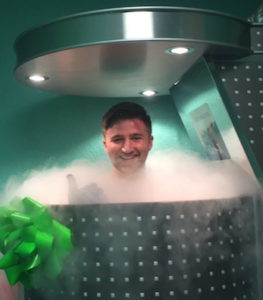Cryotherapy For Depression
Can standing in a cold chamber full of nitrogen make you feel better?
It’s one of those things that sounds like a new fad at first, but you never know until you experience it for yourself.
Cryotherapy has started to take off. Major sports teams like the Dallas Mavericks have been using it to improve athletic performance for many years now.
I decided to try it myself to see what it was really about.
Cryotherapy and Inflammation
Inflammation is part of the the body’s immune response when it is protecting itself from harmful conditions.
If you have chronic inflammation, you will likely experience anger, aggressive behavior, inner tension, or constantly feel bad. Your body is responding to a perceived threat. If there is no actual threat, the white blood cells can start attacking healthy organs or cells.
The chemical signals released by these attacked cells can cause a wide range of problems and pain. Cryotherapy’s main objective is to reduce inflammation.
How Does Cryotherapy Reduce Inflammation?
 Cryotherapy is where you stand in a tank filled with liquid nitrogen-cooled air that goes to around -130°C (-266°F) for 2-3 minutes. Cryotherapy helps reverse the effect of inflammation by constricting the blood vessels. It is similar to using an ice pack on an injury, except this time your whole body is in an ice pack, which causes a whole lot of other cool things to happen (no pun intended).
Cryotherapy is where you stand in a tank filled with liquid nitrogen-cooled air that goes to around -130°C (-266°F) for 2-3 minutes. Cryotherapy helps reverse the effect of inflammation by constricting the blood vessels. It is similar to using an ice pack on an injury, except this time your whole body is in an ice pack, which causes a whole lot of other cool things to happen (no pun intended).
Short bursts of cold can even help increase the antioxidants glutathione and superoxide dismutase, which can improve overall day-to-day functioning.
Since you are on this site, you’re probably looking at ways to feel better, especially mentally. Chronic inflammation can be caused by multiple factors, such as pollution or poor diet, and some people have even gone as far as to say that depression is really just a symptom of inflammation.
Cryotherapy for Depression
A large body of research now suggests that depression is often associated with a low-grade, chronic inflammatory response and is accompanied by increased oxidative stress.
Like we talked about earlier, inflammation can cause a whole host of problems, such as reduced appetite, pain, and even making it harder to sleep.
 In 2015, there was a study conducted that found that people with depression had 30% more inflammation in their brain than those that didn’t have depression.
In 2015, there was a study conducted that found that people with depression had 30% more inflammation in their brain than those that didn’t have depression.
One study conducted found that depression is often present in inflammatory illnesses, and even 1/4 of people who take interferon, a medication for hepatitis C that can cause inflammation, develop major depression.
It turns out that inflammation produces cytokines which cause neurological symptoms just like depression does.
Antidepressants have been shown to reduce these cytokines and this can explain why some people see a big difference when they take them.
However, make sure to read all the comments in my article about getting off antidepressants and my experience taking Celexa before opting for the band-aid solution that antidepressants often are.
Cryotherapy for Anxiety
Cryotherapy produces a lot of endorphins after you get out due to the body reacting to the stress of being cold. Anxiety and depression are often two sides of the same coin, and the same beneficial effects we get with reducing inflammation affect anxiety as well.
If you have ever felt anxious and noticed your anxiety went away or was reduced after going for a hard run or after lifting weights in the gym, stepping out of a cryotherapy tank can feel the same way.
My Own Experience Using Cryotherapy
After going through a lot of stress with a new job and dealing with chronic health issues, I got to the point where my cortisol was off and inflammation was high in my body. I was having a hard time sleeping and would get pain behind my eyes, joint pain, headaches, etc. from eating food and daily stressors.
A doctor told me that if I didn’t slow down and heal myself, my adrenal glands could get really messed up and leave me with long-term problems.
I put on the brakes for a few months with work and at at the same time I heard about cryotherapy from my manager.
Like anything, it’s better to just try it and see what happens instead of thinking about it forever. So I did. The first time I went in I left feeling great and I slept better that night.
I then went to around 6-8 different places to do their introductory sessions and see who was the best.
Not All Cryotherapy Locations Are Equal
Different locations left me with different experiences. One thing I found surprising was that some of the tanks I got in didn’t even feel cold, and only a few of them I left feeling really cold.
I could tell a cryotherapy tank was cold when my stomach area felt different afterwards, like a warming up feeling internally. That was most likely due to my blood flowing to my organs, which means the cryotherapy accomplished what it was meant to accomplish.
Another factor that people don’t mention is the staff. Someone always comes in with you to monitor that you don’t look down, breathe in a bunch of nitrogen, and pass out. Some places were really awkward and I dreaded going in and having to force a conversation with a staff member that clearly didn’t care about anything I said. Other places were laid back and easy, which made it easier to want to go in and do the session.
I found one with cold tanks and great staff and signed up for a monthly membership which was $175 per month. I lived in Dallas, and I have learned that cryotherapy is cheaper in Dallas-Fort Worth than most places. Going every single day was equivalent to paying about $5-$7 per session. When it comes to health and improving your quality of life, it’s important to invest in your self and not be cheap. What’s the point of life if you feel like shit all the time?
I went everyday for 3 months and noticed a big improvement in my overall well-being. They say that you don’t build a tolerance to it, but I did notice that I didn’t get as cold after a while and didn’t feel the effects as strongly. When I wouldn’t go for a while and return, I would get the warm feeling in my belly again and leave feeling energized and alive.

Some Locations Have a Wide Range Of Slippers to Choose From
Should You Use Cryotherapy For Depression?
I’m not sure, but you will never know unless you try it.
Most places allow you to pay $10-$20 to try it out one time and see.
You’ll either lose $20 in the journey to healing yourself and learn that it doesn’t work, or you’ll find something that helps you heal and fix your depression.
Cryotherapy is interesting because it looks like it is going to be unbearably cold and painful, but taking a cold shower is harder than doing cryotherapy.
Like I mentioned earlier, just make sure you are using a good facility. You might have to try a few places before deciding whether or not cryotherapy works for you.
After you hop out, write us a comment below and let us know how it went, as long as your fingers aren’t too cold to type :).
